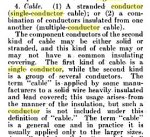What is a cable? Would four large conductors twisted together be considered a single cable? If so would this allow you to pull in multiple conductors as one cable and use the 53% fill from chapter 9? Someone mentioned this to me today where they saw it in a trade magazine.
Cabling (in the manufacturers world) is just that. Twisting individual conductors together into a specific Length of Lay. If you "cable" 4 THHN's together you have "cabled" them and they would be able to utilize the 53% fill from chapter 9 in my opinion. Note 9 specifically talks about a "multiconductor" cable, manufacturers of wire and cable utilize this specifically. Now, this does not mean it has to have an outer jacket, doing so creates a cable assembly in the eyes again of the manufacturer, but if the conductors are to be used (aka THHN/THWN-2) then they have to be installed in a raceway or cable to complete the application.
A great example of a cable without a jacket is submersible pump cable, it is "cabled" and traditionally not installed inside of a raceway or cable assembly.
Triplex is a cable yet it has no jacket or sheathing, it is twisted "cabled" conductors together to form a cable, if it is constructed into a cable assembly (e.g. AC Cable, MC Cable, TC Cable, Etc) then you do indeed have a cable but its simply a cable assembly. So from a manufacturers viewpoint the cabling of conductors for use in a cable assembly does not lessen the fact the twisting of conductors listed under 310.104 would be a cable and could use Note 9 of Table 1 accordingly.
In fact, you can buy pre-cabled conductors, on a large reel for installation in raceways everyday of the week and those pre-twisted, and in most cases pre-lubricated will have a better COE, SWP than pulling individual conductors that are subject to jam if not figured properly.
You can agree to disagree, I am simply bringing you the manufacturers view point on the term "Cabling" and "Cable". The fact we twist it (Lenth of Lay within the TOI specifications) does not remove the fact that it has to be placed in a raceway or cable (in most all cases) for protection. Every manufacturer of wire or cable will supply you with any length you wish of cabled inners, pre-lubricated, reeled and ready for installation and I believe they all consider it a "cable", just not yet a cable assembly if it is being processed to go into an MC or AC Cable Assembly.
Also here is an except from the McGraw Electrical Trade Directory that most of the manufacturers go by.



